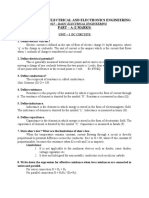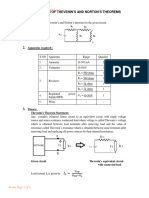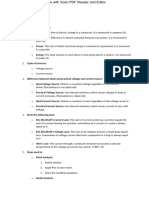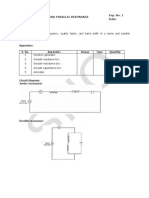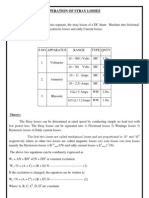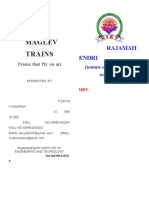100%(1)100% found this document useful (1 vote)
168 viewsThevinin and Norton
Thevinin and Norton
Uploaded by
kudupudinageshThis document describes an experiment to verify Thevenin's and Norton's theorems. Thevenin's theorem states that any linear bilateral network can be reduced to a single voltage source in series with a resistance. To verify this theorem, the open circuit voltage and equivalent resistance are measured. Norton's theorem states that any linear bilateral network can be reduced to a current source in parallel with a resistance. To verify this, the short circuit current and equivalent resistance are measured. The experimental results are recorded and compared to theoretical values. Verifying both theorems, the document concludes they are applicable to the given network.
Copyright:
Attribution Non-Commercial (BY-NC)
Available Formats
Download as DOCX, PDF, TXT or read online from Scribd
Thevinin and Norton
Thevinin and Norton
Uploaded by
kudupudinagesh100%(1)100% found this document useful (1 vote)
168 views4 pagesThis document describes an experiment to verify Thevenin's and Norton's theorems. Thevenin's theorem states that any linear bilateral network can be reduced to a single voltage source in series with a resistance. To verify this theorem, the open circuit voltage and equivalent resistance are measured. Norton's theorem states that any linear bilateral network can be reduced to a current source in parallel with a resistance. To verify this, the short circuit current and equivalent resistance are measured. The experimental results are recorded and compared to theoretical values. Verifying both theorems, the document concludes they are applicable to the given network.
Copyright
© Attribution Non-Commercial (BY-NC)
Available Formats
DOCX, PDF, TXT or read online from Scribd
Share this document
Did you find this document useful?
Is this content inappropriate?
This document describes an experiment to verify Thevenin's and Norton's theorems. Thevenin's theorem states that any linear bilateral network can be reduced to a single voltage source in series with a resistance. To verify this theorem, the open circuit voltage and equivalent resistance are measured. Norton's theorem states that any linear bilateral network can be reduced to a current source in parallel with a resistance. To verify this, the short circuit current and equivalent resistance are measured. The experimental results are recorded and compared to theoretical values. Verifying both theorems, the document concludes they are applicable to the given network.
Copyright:
Attribution Non-Commercial (BY-NC)
Available Formats
Download as DOCX, PDF, TXT or read online from Scribd
Download as docx, pdf, or txt
100%(1)100% found this document useful (1 vote)
168 views4 pagesThevinin and Norton
Thevinin and Norton
Uploaded by
kudupudinageshThis document describes an experiment to verify Thevenin's and Norton's theorems. Thevenin's theorem states that any linear bilateral network can be reduced to a single voltage source in series with a resistance. To verify this theorem, the open circuit voltage and equivalent resistance are measured. Norton's theorem states that any linear bilateral network can be reduced to a current source in parallel with a resistance. To verify this, the short circuit current and equivalent resistance are measured. The experimental results are recorded and compared to theoretical values. Verifying both theorems, the document concludes they are applicable to the given network.
Copyright:
Attribution Non-Commercial (BY-NC)
Available Formats
Download as DOCX, PDF, TXT or read online from Scribd
Download as docx, pdf, or txt
You are on page 1of 4
5.
THEVENIN'S AND NORTON'S THEOREMS
Circuit Diagrams :
To find load current (I
L
) :
To find Thevinins Resistance (R
th
) :
To find Thevinins Voltage (V
th
)
To Iind
Nortans Current (I
N
) :
Aim: To VeriIy Thevenin's and Norton's theorems.
Apparatus:
S.No. Apparatus Range Type Quantity
1 Ammeter (01) A MC 1
2 R.P.S (00V) DIGITAL 1
Rheostat 25O/5A Wire wound 1
4 Rheostat 18O/1.8A Wire wound 1
5 Rheostat 50O/ 5A Wire wound 1
6 Rheostat 100O/ 5A Wire wound 1
7 Voltmeter (00V) MC 1
1hevenin's theorem.
Statement: Thevenin's theorem states that 'In any two terminal, linear, bilateral network having a number
oI voltage, current sources and resistances can be replaced by a simple equivalent circuit consisting oI a
single voltage source in series with a resistance, where the value oI the voltage source is equal to the open
circuit voltage across the two terminals oI the network, and the resistance is the equivalent resistance
measured between the terminals with all energy sources replaced by their internal resistances.
!ROCEDURE:
(a) To find V
th
1. Connect the circuit as per the practical circuit. (Fig. 1)
2. Measure V
oc
between A and B terminals.
(b) To find R
th
1. Connect the circuit as per the practical circuit (Fig. 2)
2. Replace the voltage and current sources by open circuit and short circuit respectively and connect
a voltage source and series with an ammeter between the terminals A&B
. Note down the ammeter readings Ior diIIerent voltages.
4. Calculate R
th
V/I
5. Draw the thevenins equivalent circuit
orton's theorem:
Statement: Norton's theorem States that 'in any two terminal, linear, bilateral network with current sources,
voltage sources and resistances can be replaced by an equivalent circuit consisting oI a current source in
parallel with a resistance. The value oI the current source is the short circuit current between the two
terminals oI the network and the resistance is the equivalent resistance measured between the terminals oI
the network with all the energy sources replaced by their internal resistances.
!rocedure:
(a) To find I
N
1. Connect the circuit as per the practical circuit. (Fig. 1)
2. Measure the current I
sc
(or) I
N
through 'AB' by shortcircuiting the resistance between A and B.
(b) To find R
th
1. Connect the circuit as per the practical circuit (Fig.2)
2. Replace the voltage and current sources by open circuit and short circuit respectively and connect a
voltage source and series with an ammeter between the terminals A&B
. Note down the ammeter readings Ior diIIerent voltages.
4. Calculate R
th
V/I
5. Draw Norton's equivalent circuit.
TABULAR COLUMN
!arameters Theoretical
Values
!ractical
Values
I
L
V
TH
R
TH
I
N
RESULT : Hence Thevinin`s Theorem and Norton`s Theorems are veriIied Ior the given network.
VIVA VOCE:
1. State Thevinin`s theorem.
2. What are the limitations oI Thevinin`s theorem?
. State Norton`s theorem.
You might also like
- Load Test On Series GeneratorDocument3 pagesLoad Test On Series Generatorkudupudinagesh88% (8)
- Laboratory Exercices For Analog and Digital Circuits Using NI ELVIS II NI Multisim 2Document150 pagesLaboratory Exercices For Analog and Digital Circuits Using NI ELVIS II NI Multisim 2zohas13No ratings yet
- Load Test On DC Compund GeneratorDocument4 pagesLoad Test On DC Compund Generatorkudupudinagesh50% (12)
- Brake Test On DC Shunt MotorDocument4 pagesBrake Test On DC Shunt Motorkudupudinagesh88% (32)
- Brake Test On DC Compound MotorDocument4 pagesBrake Test On DC Compound Motorkudupudinagesh90% (10)
- Aim: - To Verify Thevenin's and Norton's Theorems. ApparatusDocument6 pagesAim: - To Verify Thevenin's and Norton's Theorems. ApparatusSree MurthyNo ratings yet
- Eca ManualDocument80 pagesEca Manualreyex25368No ratings yet
- Basic Electrical and Electronics - Question Bank With AnswerDocument93 pagesBasic Electrical and Electronics - Question Bank With Answerharish.m.2024.aimlNo ratings yet
- Question Bank With Answers: BE 8253 - Basic Electrical, Electronics and Instrumentation EngineeringDocument93 pagesQuestion Bank With Answers: BE 8253 - Basic Electrical, Electronics and Instrumentation EngineeringRajeshNo ratings yet
- Basic ElectricalDocument38 pagesBasic ElectricalARVINDNo ratings yet
- Network TheoremDocument7 pagesNetwork TheoremArslanShahidNo ratings yet
- 1basic Electrical Engineering Lab 2020-21Document82 pages1basic Electrical Engineering Lab 2020-21roberto carlos roberto carlosNo ratings yet
- Lab 3 - Thevenin TheoremDocument8 pagesLab 3 - Thevenin TheoremminhtridtaNo ratings yet
- BE3251-BASIC ELECTRICAL AND ELECTRONICS ENGINEERING-985171954-BE 3251 BEEE NotesDocument64 pagesBE3251-BASIC ELECTRICAL AND ELECTRONICS ENGINEERING-985171954-BE 3251 BEEE NotesJemima ANo ratings yet
- Electrical Circuits and Simulation Lab: List of Experiment SDocument53 pagesElectrical Circuits and Simulation Lab: List of Experiment SARVIND100% (1)
- Department of Electrical and Electronics Engineering Part - A (2 Marks)Document6 pagesDepartment of Electrical and Electronics Engineering Part - A (2 Marks)1050 SAKTHIVEL SNo ratings yet
- ET Lab ManualDocument52 pagesET Lab Manualcholleti sriram100% (1)
- Circuit Theory Lab (Ice) : Experiment No: 3Document4 pagesCircuit Theory Lab (Ice) : Experiment No: 3D V AnshuNo ratings yet
- Thevenin's Theorem and Norton's TheoremDocument9 pagesThevenin's Theorem and Norton's Theoremsnehasarkar20.7No ratings yet
- JC6TD4N7 Lab2Document8 pagesJC6TD4N7 Lab2Emre SelviliNo ratings yet
- Experiment No. 1: Verificati O N of TH Eve Nin 'S Theor emDocument37 pagesExperiment No. 1: Verificati O N of TH Eve Nin 'S Theor emakashdeep tickooNo ratings yet
- Thevenin's and Norton's Theorem-WDocument5 pagesThevenin's and Norton's Theorem-Wkrishnareddy_chintalaNo ratings yet
- EE LAB ManualDocument48 pagesEE LAB ManualManu anandNo ratings yet
- Tmp 8326749213647493341Document13 pagesTmp 8326749213647493341mohitkorgaonkar1s844No ratings yet
- Bee Lab ManualDocument62 pagesBee Lab ManualSwetha VanamNo ratings yet
- Experiment 2 C Se 209Document6 pagesExperiment 2 C Se 209gsrabonti11No ratings yet
- Circuit Thoery Lab ManualDocument57 pagesCircuit Thoery Lab ManualsrisairampolyNo ratings yet
- Thevenin's Theorem: S. No. Apparatus Range Type QuantityDocument10 pagesThevenin's Theorem: S. No. Apparatus Range Type QuantityUpender Rao SunkishalaNo ratings yet
- Ee6201 CT U1 5 QBDocument10 pagesEe6201 CT U1 5 QBsakilakumaresanNo ratings yet
- CT 2markkDocument5 pagesCT 2markkAnonymous yO7rcec6vuNo ratings yet
- Lab ManualsDocument24 pagesLab ManualsPranoy MukherjeeNo ratings yet
- Electronic Devices and CircuitsDocument12 pagesElectronic Devices and CircuitsAnandhi SrinivasanNo ratings yet
- Experiment - 1: TheoryDocument6 pagesExperiment - 1: TheoryKiran Kumar KandregulaNo ratings yet
- شيت مختبر الاسس PDFDocument23 pagesشيت مختبر الاسس PDFMohamad AlhadithyNo ratings yet
- Network TheoremsDocument14 pagesNetwork TheoremsruduitududtNo ratings yet
- BEEE Lab Manual CSVTUDocument44 pagesBEEE Lab Manual CSVTUMulty TalantedNo ratings yet
- ECE Department ECI Lab ManualDocument80 pagesECE Department ECI Lab ManualArputharaj JohnsonNo ratings yet
- QUIZ1Document3 pagesQUIZ1singamsridharNo ratings yet
- Electrical Science Manual 2023Document55 pagesElectrical Science Manual 2023ANSHUL SINGHNo ratings yet
- Network Analysis Synthesis Lab (1)Document17 pagesNetwork Analysis Synthesis Lab (1)ruchi tiwariNo ratings yet
- (291882886) Et-Lab-ManualDocument31 pages(291882886) Et-Lab-ManualvpzfarisNo ratings yet
- EC3271-CIRCUIT ANALYSIS LABORATORY-166789196-CA Lab ManualDocument33 pagesEC3271-CIRCUIT ANALYSIS LABORATORY-166789196-CA Lab ManualVijaya RNo ratings yet
- Chapter 2: DC Circuit TheoryDocument37 pagesChapter 2: DC Circuit TheoryTaonga Nhambi100% (1)
- Thevenin Equivalent CircuitsDocument5 pagesThevenin Equivalent CircuitsAhmed Hamouda100% (1)
- Ee 101 Lab02 KirchhoffDocument5 pagesEe 101 Lab02 KirchhoffPetruț CătălinNo ratings yet
- Ee6211 - Electric Circuit LabDocument101 pagesEe6211 - Electric Circuit Labsujith100% (1)
- Ee8251 Circuit TheoryDocument73 pagesEe8251 Circuit TheoryVbalaji VaithiyanathanNo ratings yet
- Electric Circuits Lab ManualDocument69 pagesElectric Circuits Lab ManualgeethaNo ratings yet
- Electrical Circuit Lab ManualDocument38 pagesElectrical Circuit Lab Manualecessec67% (3)
- Chapter 2 DC Circuit TheoryDocument37 pagesChapter 2 DC Circuit TheoryTynoh MusukuNo ratings yet
- Experiment 16 Circuit Analysis Techniques: Figure 16-1 R R + R + RDocument14 pagesExperiment 16 Circuit Analysis Techniques: Figure 16-1 R R + R + RMuhammad Usman ArifNo ratings yet
- ECSE 200 - Electric CircuitsDocument5 pagesECSE 200 - Electric CircuitsAlainNo ratings yet
- EE209 Experiment 4Document4 pagesEE209 Experiment 4Greed RvYNo ratings yet
- Beee Unit - 1Document8 pagesBeee Unit - 1Pradeev BalakrishnanNo ratings yet
- Experiment 4 CADocument3 pagesExperiment 4 CAseemabNo ratings yet
- Thevenin's Theorem: TH TH TH THDocument2 pagesThevenin's Theorem: TH TH TH THashaNo ratings yet
- ee_101_lab02_kirchhoff_F07Document7 pagesee_101_lab02_kirchhoff_F07April Marie De GuzmanNo ratings yet
- Superposition and Norton TheoremDocument24 pagesSuperposition and Norton TheoremMahmudul AlamNo ratings yet
- Electric Circuit AnalysisDocument12 pagesElectric Circuit AnalysisMATHANKUMAR.SNo ratings yet
- Design of Electrical Circuits using Engineering Software ToolsFrom EverandDesign of Electrical Circuits using Engineering Software ToolsNo ratings yet
- Power Systems and Simulation Laboratory: Department of Electrical and Electronics EngineeringDocument48 pagesPower Systems and Simulation Laboratory: Department of Electrical and Electronics EngineeringkudupudinageshNo ratings yet
- On of Stray LossesDocument5 pagesOn of Stray LosseskudupudinageshNo ratings yet
- Field TestDocument5 pagesField Testkudupudinagesh100% (3)
- OCCDocument4 pagesOCCkudupudinageshNo ratings yet
- Z and Y ParametersDocument6 pagesZ and Y Parameterskudupudinagesh100% (12)
- Swinburne S Test On DC Shunt MotorDocument5 pagesSwinburne S Test On DC Shunt Motortamann2004No ratings yet
- Super Position and ReciprocityDocument6 pagesSuper Position and ReciprocitykudupudinageshNo ratings yet
- Time Responseof RL and RC NetworksDocument5 pagesTime Responseof RL and RC Networkskudupudinagesh100% (1)
- Regulation of AlternatorDocument6 pagesRegulation of Alternatorkudupudinagesh100% (1)
- Max Power TransferDocument5 pagesMax Power TransferkudupudinageshNo ratings yet
- O.C & S.C of Single Phase TransformerDocument8 pagesO.C & S.C of Single Phase Transformerkudupudinagesh50% (2)
- Brake Test On DC Shunt MotorDocument5 pagesBrake Test On DC Shunt MotorkudupudinageshNo ratings yet
- Maglev Trains: Trains That Fly On AirDocument21 pagesMaglev Trains: Trains That Fly On AirkudupudinageshNo ratings yet
- The Poor Man's Super ComputerDocument12 pagesThe Poor Man's Super ComputerkudupudinageshNo ratings yet
- Maglev Trains: Rajamah EndriDocument9 pagesMaglev Trains: Rajamah EndrikudupudinageshNo ratings yet















